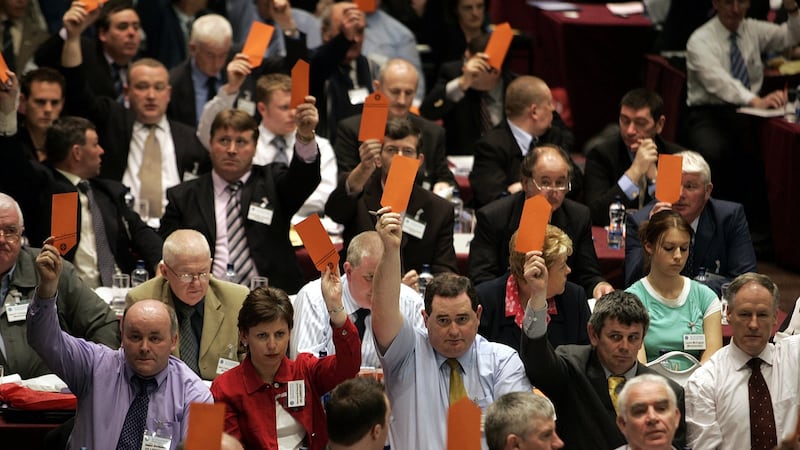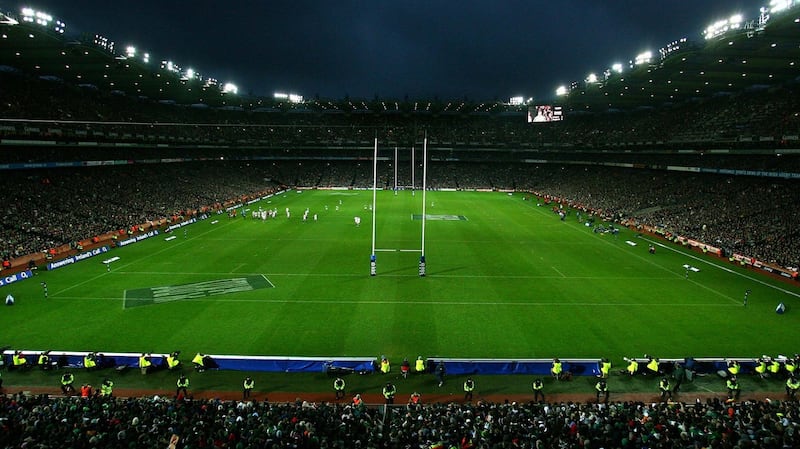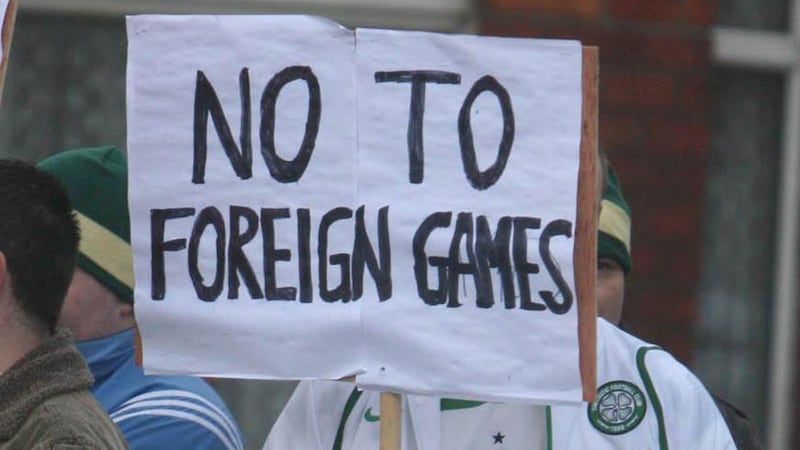I always thought – even at the time – that the whole Ireland-England thing in the 2007 Six Nations at Croke Park was a bit over-wrought. The countries played each in Dublin every two years without major flashpoints. It wasn't like the crowd from Bloody Sunday were about to be transported through time to stand there in mute disapproval.
If anything, England would be welcome visitors. It was still remembered that in 1973 they had travelled to Dublin when the previous year Wales and Scotland had refused. On a more practical consideration they hadn't beaten Ireland in four years.
There had been all sorts of faux agonising over whether the English anthem would be 'respected' at the new rugby venue and how this might reflect our 'maturity' as a nation. Observer journalist Kevin Mitchell rang me the week before to ask about the cultural reverberations of the event.
I remember saying to him that God Save the Queen was played at Lansdowne Road without the crowd booing so it was hard to see why things would be any different in Croke Park with exactly the same sort of people in attendance, albeit in greater numbers.
The anthems came and went amid much emotion but impeccably observed.
In the lead-up to the match there was a great deal of fussing over the ground’s history.
Former Ireland player Conor O'Shea apparently gave the England team a 'talk' on the significance of Croke Park, which must have left them a bit nonplussed at how a routine international had turned into some sort of Truth Commission.
But there it was. A 43-13 win and according to former GAA museum director, Tim Carey, the first try scored by Girvan Dempsey in more or less the same spot as Mick Hogan had been shot in 1920 – as the England players were by then doubtlessly aware.
********************

It was hard to read the mood of congress on the Saturday afternoon of April 16th, 2005. Not that the prevailing view was in any doubt but if Croke Park were to be opened to other sports while Lansdowne Road was being redeveloped, those supporting the removal of Rule 42 would have to outnumber opponents by at least two to one, the required weighted majority.
So it was a conditioned cliff-hanger and small things could tilt that balance. For added drama the congress was being held for the first time in decades in the very venue under discussion.
First there was a proxy battle with the previous evening’s Central Council voting for a secret ballot. That was approved by congress and spread ripples of gloom among the reformers.
Amusingly, in the aftermath there were complaints that such attitudes amounted to a scandalous impugning of the delegates – the implication that if they weren’t being watched, they wouldn’t honour mandates.
Yet that was exactly what had happened four years previously when renegade voting had indeed tilted the verdict and prevented the contentious rule from being binned in 2001.
Anyway, pessimism intact, the debate unfolded. Those in favour largely relied on arguments of neighbourliness and not wanting to force the Ireland rugby and soccer teams to play home internationals overseas whereas opposition centred on the selling of principles and the danger of letting competitors use your premises as a shop window.
One delegate, Seán Quirke triggered a few laughs: "Sure, we have already played American football here and, I can guarantee you, it hasn't caught on in Wexford anyway."
The most devastating put-down came from the opposition hot spot of the former presidents’ table. The late Con Murphy said that acceptance of the motion would mean “the formation of a new association that caters for everything and stands for nothing”.
If there was a keynote to the successful arguments, it had come four years previously during the 2001 skirmish. Europe delegate Cathal Lynch, a Leitrim man, had based his case on recognition of the modern world in which Gaelic games operated.
"We will be playing our competitions on a cricket pitch in Guernsey, a soccer ground in Luxembourg and a rugby club in The Hague. If this motion is defeated today, will we follow the logic and not avail of these venues? The world is changing . . ."
The result wasn’t expected – I was sure it wasn’t going to succeed – and there was an almost audible intake of breath after then president Seán Kelly, a long-term advocate of change, read out the result, 227-97. It was emphatic but 12 switched votes and the GAA would have been digging in for a bombardment of negative publicity.
Clare's Noel Walsh, who died only a fortnight ago and was a relentless campaigner for the reform, said in the immediate aftermath: "Democracy is a wonderful thing."
********************

When 2007 dawned with Lansdowne Road demolished, the choreography was important. First up would be the Six Nations match against France, which wouldn't have anything like the historical baggage of the England fixture – beyond being as I noted afterwards "typical of French involvement in our affairs down the ages: late and greatly disappointing".
I still recall that on the way in to that match I was within earshot of a former (not extravagantly capped) rugby international, who was loudly telling his travelling companions that they’d just have to put up with the indignity of the whole thing until Lansdowne Road was ready.
At the ground I met former GAA president, Paddy McFlynn, since sadly departed. His first visit to Croke Park he said was in 1933 for Cavan’s – and Ulster’s – first All-Ireland win.
This was less than a decade after the Free State government had contributed £10,000 towards the cost of building the first Hogan Stand in time for the 1924 Tailteann Games. In all he had seen the four sides of Croke Park redeveloped not once but twice over those 74 years.
Now, there was history.
********************
Where on earth had such a strange provision come from? Rule 42 didn’t actually go back into the mists of GAA history, even if its origins arguably did. In the separatist fervour of the association’s early days, it used exclusion to strengthen the national consciousness. The sense of doing something as an expression of your cultural identity led to a kind of sporting apartheid.
Members of the security forces – British army and Irish police – were barred from membership and GAA members were not allowed to play other sports, or in a lesser remembered clause of the rule, attend dances in those rival clubhouses.
The ‘Ban’ as the latter was known eventually went in 1971 after over a decade of campaigning through incrementally narrowing defeats. The security forces prohibition also went through the process of proposal, defeat, regroup until the imminence of recruiting members for the new PSNI drove its abolition as late as 2001.
Rule 42 had actually been introduced as an emollient for conservatives in 1971, methadone to wean them off the cherished prohibition and arguably a stroke, as there didn’t appear to be any clamour at the time for it.
There was a practical echo of that famous congress in Belfast in that what brought down the Ban 49 years ago had been a little noticed proposal accepted in 1968 that clubs conduct a plebiscite on whether they wanted to keep it.
Once ordinary members had a say, the prohibition was doomed. Only two counties ended up opposing – Antrim and Sligo, the latter coincidentally proposing the motion that opened Croke Park 34 years later.
Similarly in 2005, ordinary club delegates had started to make their feelings known and although their views were disrespected by some delegations, enough were to set up the historic vote.
********************
The week before the England match there had also been a suggestion that Peter Hain, the British government's Northern Ireland secretary, might lay a wreath before the match in memory of those who died on Bloody Sunday. The GAA were not impressed.
I got a strong reaction out of the blue from then PRO Danny Lynch, who along with the president Nickey Brennan and director general Liam Mulvihill had met a British delegation a fortnight previously and made no secret of the fact that they didn't think it appropriate – even as a gesture – given sensitivities within the association about the opening of Croke Park.
“The approach lacked sensitivity and understanding as to how this matter should be dealt with,” he said on the Monday. “Our belief was that it should be a standalone exercise conducted genuinely and unequivocally without any ambiguity about the gesture. The reality is that this was placed on the public agenda through leaks to try and pre-empt our reaction.”
At the time I thought that the response was unduly prickly but there was a number of issues involved, as another senior source in the GAA told me at the time.
“This whole thing was never sold as anything other than a practical gesture of providing a venue for other sports while they were temporarily homeless. Trying to cast it as a major political gesture is something we’ve been trying to avoid.”
It might appear odd at this stage but the minority who opposed the opening were intensely unhappy. Writer, GAA journalist and All-Ireland winner JJ Barrett withdrew his father's medal collection – Joe Barrett had captained Kerry during the four-in-a-row, 1929-32 - from the Croke Park museum in protest at God Save the Queen being played in the stadium.
********************

On the evening of the England match I was in the house of a friend, who had been asked to sort out Trevor McDonald with a match ticket and then invited the veteran broadcaster to dinner where he talked engagingly about his time as ITV correspondent in Northern Ireland.
He also mentioned the famous protester on the North Circular Road on the way to Croke Park, who had been wearing a Celtic jersey and holding a placard giving out about foreign games being played there.
Despite having explained to him the background to the ban and its history – to the, hmmm, enthralment of all – I noted that in an interview some years later Sir Trevor listed Jamie Lee Curtis and Sandra Bullock as his 'dream dinner guests'.
Hey Trevor, what about me and Rule 42?















